The Featured Creatures collection provides in-depth profiles of insects, nematodes, arachnids and other organisms relevant to Florida. These profiles are intended for the use of interested laypersons with some knowledge of biology as well as academic audiences.
Introduction
The potato tuberworm Phthorimaea operculella (Zeller), also known as potato tuber moth or tobacco splitworm, is an oligophagous pest (an insect feeding on a restricted range of food plants) of crops belonging to the family Solanaceae (mainly potatoes [Solanum tuberosum L.], tomatoes [Solanum lycopersicum L.] and tobacco [Nicotiana tabacum L.]). Phthorimaea operculella has been a minor pest of tobacco for more than 100 years. However, in North Carolina, this pest has emerged as a problem in tobacco plantings over the last five years. This pest has been reported in tropical, subtropical and Mediterranean agro-zones (Westedt et al. 1998, Flanders et al. 1999, Visser 2005, Golizadeh and Esmaeili 2012).
The potato tuber worm affects production, reduces quality of the produce and increases the risk of infection by plant pathogens. The common name potato tuberworm is given to its damaging larval stage. There are two species in different genera with similar names: Tecia solanivora (Povolny) and Symmetrischema tangolias (Gyen). Tecia solanivora (Povolny), the Guatemalan potato moth, is found in Central America and northern South America and attacks potatoes that are still in the field as well as stored potatoes. The Andean or South American potato tuber moth, Symmetrischema tangolias (Gyen), is a pest of stored potatoes in the Andes.
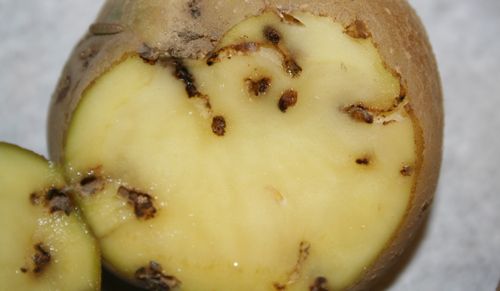
Credit: Silvia I. Rondon, Hermiston Agricultural Research and Extension Center, Oregon State University.
Distribution
Potato tuberworm is a cosmopolitan pest. In the United States, it has been reported in at least 25 states from the Atlantic to the Pacific coast. This pest occurs in most areas where potatoes or other solanaceous plants are grown. It was first recorded in California in 1856 (Alvarez et al. 2005). However, it was not a major concern for growers in the Pacific Northwest until 2002, when severe potato tuberworm damage was documented in a field near Hermiston, Oregon (Rondon et al. 2007). It occurs widely in Africa (Ethiopia, Egypt, Kenya), Asia (Iran, Syria), Europe, the Americas (Latin America, Andes of Peru and Bolivia) and Oceania (Australia and New Zealand) (Saour 2004, Vargas et al. 2004, Davidson et al. 2006, Golizadeh and Esmaeili 2012, Golizadeh and Zalucki 2012, Ahmed et al. 2013, Kroschel et al. 2013). Potato tuberworm has been reported in more than 90 countries (Anonymous 2013).
Host Range
Potato tuberworms are mainly associated with potatoes; however, they have been observed feeding on other plants, such as tomatoes, eggplants (Solanum melongena L), peppers (Capsicum spp.), tobacco and wild solanaceous plants like Jimson weed or datura (Datura stramonium L.) (Alvarez et al. 2005). In the Pacific Northwest, potato tuberworms have only been reported infesting potatoes (Rondon et al. 2007).
Life History
Eggs, larvae and pupae of potato tuberworm can potentially survive in volunteer potatoes, or in the soil after harvest. Potato tuberworm is known to survive in the soil as pupae. Larval development is interrupted by temperatures below 50°F. Larvae can pupate in the soil, discarded piles of potatoes, dead leaves, on storage walls, or on eyes of stored tubers (Raman 1980). They can also pupate in crevices in walls, floors, and crates.
All instars may occur together in overlapping generations. There are two to eight generations per year depending upon climatic conditions. There are usually two generations per year in temperate climates of North America (Alvarez et al. 2005). In the Northern Hemisphere, peak populations of adults occur from May through June in Israel, from June through August in Yemen, and from April to October in the United States. Generation time can vary from two weeks during summer to seven or eight months if the cycle is interrupted by winter. Winter populations can be active in storage facilities where optimum temperature for survival is maintained. Potato tuber moths can move up to 0.15 miles between crops to infest plants or tubers. Long distance movement of potato tuberworms occurs when infested tubers are accidentally transported (Alvarez et al. 2005).
Eggs
When foliage is not available, potato tuberworm moths can crawl short distances through cracks in loose soil to find a tuber they will use as an oviposition site. In four days, the adult female can deposit 60 to 200 eggs singly or in small clusters directly on host plant parts such as the stem, underside of leaves, or in the eye cracks and indentations on tubers. Eggs are smooth and oval, and they can be pearly white to yellowish (before hatching) in color. The eggs usually hatch after five days.
Larvae
Larvae are 0.5 to 0.6 inch long and white or yellow with a brown head and prothorax (midsection of the insect body) (Raman 1980, Alvarez et al. 2005). The thorax has small black points and bristles on each segment. The color of larvae changes from white or yellow to pink or green as they mature. The larvae feed on their host plants for up to two weeks before pupation.
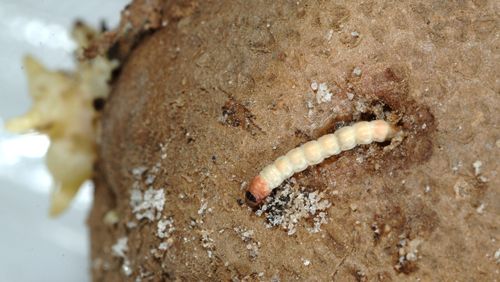
Credit: Oregon State University Extension.
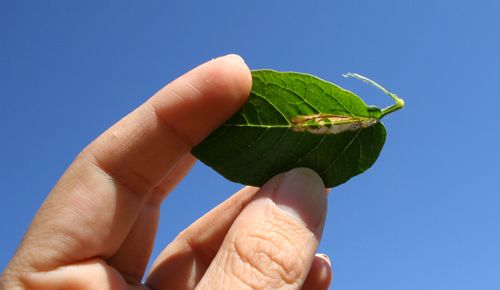
Credit: Silvia I. Rondon, Hermiston Agricultural Research and Extension Center, Oregon State University.
Pupa
Pupae are white, narrow and 0.5 inch long. Depending upon climatic conditions, pupae take 10 to 30 days to fully develop (Raman 1980, Alvarez et al. 2005). The silken cocoon spun around pupae can become covered with soil and debris.
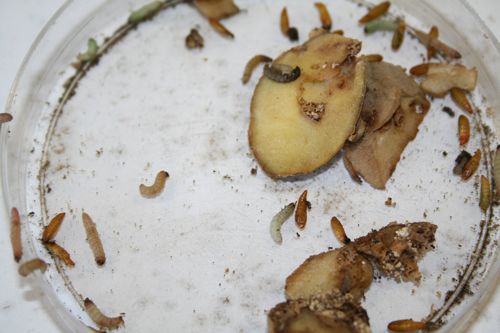
Credit: Silvia I. Rondon, Hermiston Agricultural Research and Extension Center, Oregon State University.
Adults
The moths are narrow bodied, silver gray in color, and 0.4 inch long with a wing span of 0.5 inch. Wings are grayish-brown, fringed and elongate with small brown or black markings. Both pairs of wings have fringed edges. At rest, the wings are held close to the body, giving the moth a slender appearance. The forewings are yellowish gray with dark spots (2–3 dots on males and characteristic "X" pattern on females); the hind wings are gray (Raman 1980, Alvarez et al. 2005).
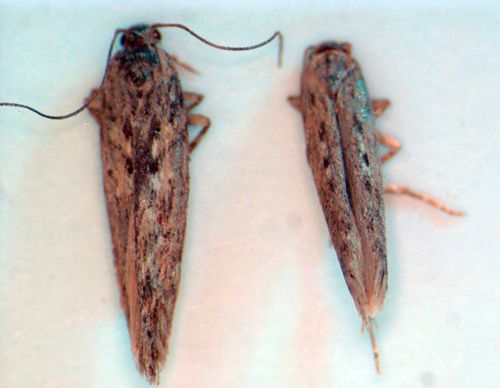
Credit: Silvia I. Rondon, Hermiston Agricultural Research and Extension Center, Oregon State University.
The adults are fast fliers and like most other moths require an insect-collecting net for capturing. These moths live for one to two weeks, are crepuscular (active at dawn and dusk), and feed on nectar. Females are slightly larger than males. Mating begins 24 hours after emergence.
Damage
Larvae feed on potato leaves, stems, petioles, and, more importantly, potato tubers in the field and in storage. The newly hatched larvae create mines on leaves by feeding on leaf tissue while leaving the upper and lower epidermis of the leaf intact. They prefer feeding on young foliage (Trivedi and Rajagopal 1992). Typical damage results from larvae boring tunnels in tubers. Larvae depositing their excreta make tubers unfit for consumption. Potato tuber eyes become pink due to deposition of silk and excrement by potato tuberworm infestation. Severe infestations result in yield and quality losses during storage where previously infested tubers are stored with healthy potato tubers (Malakar and Tingey 2006, Rondon 2010). This generally destroys the entire crop of stored potatoes.
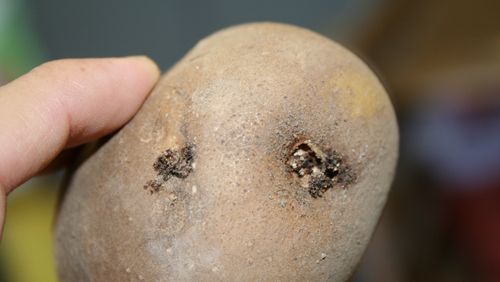
Credit: Silvia I. Rondon, Hermiston Agricultural Research and Extension Center, Oregon State University.
Most economic damage occurs to potato tubers in storage conditions in developing countries and is caused by larval feeding. Presence of even one larva is sufficient to spoil and destroy a tuber. Rapidly moving caterpillars penetrate the tubers, form galleries coated with silken threads and eject frass outside the tuber. On leaves, caterpillars form galleries and then penetrate other plant parts. After two to three weeks, caterpillars leave the plant (caterpillars can move through cracks in soil) and pupate on walls of potato bags lying in potato fields. Fungi, bacteria, and mites can develop inside the tunnels made by the larvae, which causes the tubers to rot and emit an unpleasant smell.
Stored crop losses in potatoes ranging from 50% in Yemen and Peru; 86% in Tunisia, Algeria and Turkey; 90% in Kenya; and 100% in India and the Philippines have been reported (Alvarez et al. 2005). In Egypt, potato tuber moth has caused up to 100% losses to potato plants in fields as well as in storage (Ahmed et al. 2013). Potato tuber moth is also a pest of tomatoes where larvae damage the leaves, stems, and unripe fruits.

Credit: Silvia I. Rondon, Hermiston Agricultural Research and Extension Center, Oregon State University.
Monitoring
Monitoring of potato tuber moth is a critical part of its management. Pheromone traps that attract males have been effective for monitoring potato tuber moth populations. Monitoring is one of the most important components of an integrated pest management (IPM) plan for potato tuber moth. Monitoring gives an indication of insect presence, population and distribution and allows for timing of pesticide applications for its management. Pan-water traps baited with the pheromone can be used for attracting and monitoring adult male populations. These traps are easy to use and clean between readings. Four traps per quadrant of a circle, about 50 ft from the periphery of the circle are suggested for monitoring in field. No economic threshold level (ETL) has been determined for crop damage or yield loss in fields. However, checking traps twice a week is suggested, and pesticide application is recommended in case of high population (e.g., 15 to 20 moths/trap/night) (Anonymous 2013).

Credit: Silvia I. Rondon, Hermiston Agricultural Research and Extension Center, Oregon State University.
Management
The most common method of control of Phthorimaea operculella is pesticides (Dillard et al. 1993). The development of pesticide resistance, resurgence of pest populations and potential detrimental effects of synthetic pesticides on nontarget organisms has led to the adoption of integrated pest management (IPM) strategies. It is important to know the biology and distribution of a pest for an IPM program to be successful.
Field Management
Cultural Control
Weeds and volunteer plants can act as alternate hosts for potato tuberworms and should be eliminated from fields and surrounding areas. Deep planting and good coverage of potato seeds with soil more than 2 inches during hilling helps protect damage by adults and larvae. Discard infested tuber seeds; only use healthy seed tubers for planting. Vines should not be used for covering tubers as they wilt after some time and larvae and moths can penetrate the cover to reach underlying tubers.
Harvest soon after crop maturity. Moth populations are maintained in plant and tuber debris in the field in the absence of a main crop. Therefore, timely field cleanliness is an important preventive measure. Cull piles should be destroyed to reduce overwintering stages of potato tuberworm. Avoid leaving harvested tubers overnight in the field because these potatoes could act as egg-laying sites for potato tuber moth (Raman 1980, Alvarez et al. 2005, Rondon et al. 2007, Anonymous 2013).
Soil Management and Irrigation
Irrigation is the most effective preventative method under dry conditions (Raman 1980). Enough irrigation should be provided to not allow cracks to develop deeper than two inches in the soil. It is recommended that fields should be irrigated after vine desiccation to avoid cracks in the soil and that harvest of tubers occurs as soon as the skin sets (Anonymous 2013).
Resistant Varieties
Host plant resistance enables plants to avoid, tolerate, or recover from pest infestations (Tingey 1986, Panda and Khush 1995). The efficacy of other control methods can be increased using resistant potato cultivars, thus reducing use of insecticides (Arnone et al. 1998, Golizadeh and Esmaeili 2012). Rondon et al. (2013) studied potato lines at Oregon, some of which hold promising results for controlling mines and number of larvae in potato tubers. An earlier study was conducted at Oregon by Rondon et al. (2009), and it was confirmed that tubers of the transgenic clone Spunta G2 were resistant to potato tuberworm damage. The resistance germplasm to potato tuberworm is an important part of an IPM program for potato tuberworm.
Biological Control
Natural enemies of potato tuber moth can be used as a part of an IPM program. The parasitoids Copidosoma koehleri and Bracon gelechiae Ashmead (Hymenoptera: Braconidae) have been used with some success in South America and Australia, respectively (Symington 2003, Alvarez et al. 2005).
Bio Pesticides and Natural Chemicals
Bacillus thuringiensis (Bt) formulations have proved effective for potato tuber moth control in various parts of world (Alvarez et al. 2005).
In several South American countries, PhopGV-based biopesticides (Phthorimaea operculella granulovirus (PhopGV), genus: Betabaculovirus of the arthropod-infecting Baculoviridae) are used to control either Phthorimaea operculella or Tecia solanivora (Zeddam et al. 2013).
Chemical Control
Chemical control might be necessary when adults or larvae are present. For chemical recommendations for commercial growers or home gardens, consult your local county Extension service and be sure to follow all local laws regarding pesticide use.
Storage Management
Potato tuberworm is a year-long problem under storage conditions due to continuous breeding of this pest. The length of life cycle of potato tuberworm is highly dependent on temperature. So, storage temperature should always be kept below 52°F. Monitoring in storage situations relies on the use of pheromone traps. Under storage conditions, cultural control options involve elimination of damaged tubers. Screens should be installed at entry points to exclude moths.
Sanitation of storage facility walls, floors and ceilings is very important. Treat the facility with an approved pesticide if this pest was detected the previous year. Use new or thoroughly sanitized potato sacks, crates, or other containers. Bt spray can be used on tubers that are mainly used for human consumption, and pyrethroids on tubers used for seed purpose (Anonymous 2013).
Selected References
Ahmed AAI, Hashemb MY, Mohamedc SM, Shimaa Khalila SH. 2013. Protection of potato crop against Phthorimaea operculella (Zeller) infestation using frass extract of two noctuid insect pests under laboratory and storage simulation conditions. Archives of Phytopathology and Plant Protection. DOI:10.1080/03235408.2013.795356.
Alvarez JM, Dotseth E, Nolte P. 2005. Potato tuberworm a threat for Idaho potatoes. University of Idaho Extension, Idaho Agricultural Experiment Station, Moscow, ID. (31 March 2020)
Anonymous. 2013. Potato tuber moth- Tuberworm. CropWatch: Potato Education Guide, UNL Extension. University of Nebraska-Lincoln, Lincoln, NE. (31 March 2020)
Arnone S, Musmeci S, Bacchetta L, Cordischi N, Pucci E, Cristofaro M, Sonnino A. 1998. Research in Solanum spp. of sources of resistance to the potato tuber moth, Phthorimaea operculella (Zeller). Potato Research 41:39–49.
Clough GH, Rondon SI, DeBano SJ, David N, Hamm PB. 2010. Reducing tuber damage by potato tuberworm (Lepidoptera: Gelechiidae) with cultural practices and insecticides. Journal of Economic Entomology 103:1306–1311.
Davidson MM, Butler RC, Wratten SD, Conner AJ. 2006. Field evaluation of potato plants transgenic for a cry1Ac gene conferring resistance to potato tuber moth, Phthorimaea operculella (Zeller) (Lepidoptera: Gelechiidae). Crop Protection 25:216–224.
Dillard HR, Wicks TJ, Philip B. 1993. A grower survey of diseases, invertebrate pests, and pesticide use on potatoes grown in South Australia. Australian Journal of Experimental Agriculture 33:653–661.
Flanders K, Arnone S, Radcliffe E. 1999. The potato: genetic resources and insect resistance, pp. 207-239. In: Clement SL, Quisenberry SS (eds.), Global plant genetic resource for insect resistant crops. CRC, Boca Raton, FL.
Golizadeh A, Esmaeili N. 2012. Comparative life history and fecundity of Phthorimaea operculella (Lepidoptera: Gelechiidae) on leaves and tubers of different potato cultivars. Journal of Economic Entomology 105:1809–1815.
Golizadeh A, Zalucki MP. 2012. Estimating temperature-dependent developmental rates of potato tuberworm, Phthorimaea operculella (Lepidoptera: Gelechiidae). Insect Science 19:609–620.
Kroschel J, Sporleder M, Tonnang HEZ, Juarez H, Carhuapoma P, Gonzales JC, Simon R. 2013. Predicting climate-change-caused changes in global temperature on potato tuber moth Phthorimaea operculella (Zeller) distribution and abundance using phenology modeling and GIS mapping. Agricultural and Forest Meteorology 170:228–241.
Malakar R, Tingey WM. 2006. Aspects of tuber resistance in hybrid potatoes to potato tuberworm. Entomologia Experimentalis et Applicata 120:131–137.
Medina RF, Rondon SI, Reyna SM, Dickey AM. 2010. Population structure of Phthorimaea operculella (Lepidoptera: Gelechiidae) in the United States. Environmental Entomology 39:1037–1042.
Panda N, Khush GS. 1995. Host plant resistance to insects. CAB International, Oxon, United Kingdom.
Raman KV. 1980. The potato tuber moth. Technical information bulletin 3. International potato center Lima, Peru. (Revised edition 1980)
Rondon SI, DeBano SJ, Clough GH, Hamm PB, Jensen A, Schreiber A, Alvarez JM, Thornton M, Barbour J, Dogramaci M. 2007. Biology and management of the potato tuberworm in the Pacific Northwest. A Pacific Northwest Extension publication. Oregon State University, University of Idaho, Washington State University. (31 March 2020)
Rondon SI, Hane DC, Brown CR, Vales MI, Dogramaci M. 2009. Resistance of potato germplasm to the potato tuberworm (Lepidoptera: Gelechiidae). Journal of Economic Entomology 102:1649–1653.
Rondon SI. 2010. The potato tuberworm: a literature review of its biology, ecology, and control. American Journal of Potato Research 87:149–166.
Rondon SI, Brown CR, Marchosky R. 2013. Screening for resistance of potato lines to the potato tuberworm, Phthorimaea operculella (Zeller) (Lepidoptera: Gelechiidae). American Journal of Potato Research 90:71–82.
Saour G. 2004. Efficacy assessment of some Trichogramma species (Hymenoptera: Trichogrammatidae) in controlling the potato tuber moth Phthorimaea operculella Zell. (Lepidoptera: Gelechiidae). Journal of Pest Science 77:229–234.
Sharaby A, Abdel-Rahman H, Moawad S. 2009. Biological effects of some natural and chemical compounds on the potato tuber moth, Phthorimaea operculella Zell. (Lepidoptera: Gelechiidae). Saudi Journal of Biological Sciences 16:1–9.
Sisay A, Ibrahim A. 2012. Evaluation of some potential botanicals to control potato tuber moth, (Phthorimaea operculella) under storage condition at Bako, western Ethiopia. eSci Journal of Plant Pathology 01:14–18.
Symington CA. 2003. Lethal and sublethal effects of pesticides on the potato tuber moth, Phthorimaea operculella (Zeller) (Lepidoptera: Gelechiidae) and its parasitoid Orgilus lepidus Muesebeck (Hymenoptera: Braconidae). Crop Protection 22:513–519.
Tingey WM. 1986. Techniques for evaluating plant resistance to insects, pp. 251–284. In: Miller JR, Miller TA, Berenbaum M (eds.), Insect Plant Interactions. Springer, New York, NY.
Trivedi TP, Rajagopal D. 1992. Distribution, biology, ecology and management of potato tuber moth, Phthorimaea operculella (Zeller) (Lepidoptera: Gelechiidae): a review. Tropical Pest Management 38:279–285.
Vargas B, Rubio S, López-Avila A. 2004. Estudios de hábitos y comportamiento de la polilla guatemalteca Tecia solanivora (Lepidoptera: Gelechiidae) en papa almacenada. Revista Colombiana de Entomología 30:211–217.
Visser D. 2005. Guide to potato pests and their natural enemies in South Africa. Arc- Roodeplaat Vegetable and Ornamental Plant Institute, Pretoria, South Africa.
Westedt AL, Douches DS, Pett W, Grafius EJ. 1998. Evaluation of natural and engineered resistance mechanisms in Solanum tuberosum L. for resistance to Phthorimaea operculella Zeller. Journal of Economic Entomology 91:552–556.
Zeddam J-L, Lèry X, Gómez-Bonilla Y, Espinel-Correal C, Páez D, Rebaudo F, López-Ferber M. 2013. Responses of different geographic populations of two potato tuber moth species to genetic variants of Phthorimaea operculella granulovirus. Entomologia Experimentalis et Applicata 149:138–147.